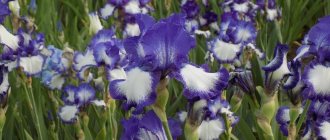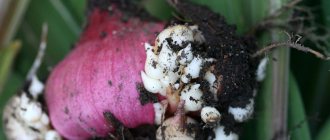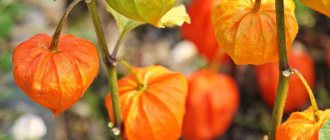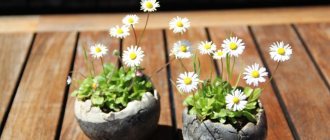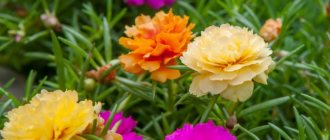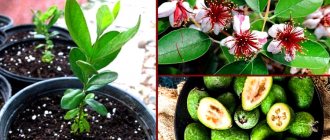Home » Flowers and plants » Outdoor plants » ? Perennials
Vladimir 03/24/2020
20952 Views
In Kievan Rus they called it “varesnets”, which means “frost” in Old Slavic. Perhaps it was so named because the flowers bloom in early autumn and last until frost. Or maybe because the friendly flowering resembles snow cover. This unique plant successfully exists only in symbiosis with fungal mycelium on poor sandy soils. That is why planting and caring for heather, which is radically different from other plants, requires an individual approach. How to choose a shrub, where to place it in the garden, and how to care for it will be discussed in our article.
Introduction
The plant gave its name to the first autumn month, which among the Slavic peoples is called “Veresen”. Heather is an excellent honey plant from which bees collect the last pollen of the year. Heather honey is not just a beautiful legend, sung by Robert Stevenson in the poem of the same name, it is a wonderful reality.
Modern landscapes are decorated with more than 500 varieties, which are planted in separate gardens or rock gardens.
From a botanical point of view, the species Common Heather (Calunea vulgaris) is characterized as a semi-evergreen subshrub. Its shoots become woody partially in the lower part, and small leaves remain green only at the ends of the branches.
Like most representatives of the family of the same name, it is able to survive exclusively in close union with fungal mycelium. The plant extracts nutrients from poor soil thanks to fungal threads - hyphae.
Natural heather plantations are found in the northern part of the Eurasian continent
Under the stems of creeping plantings, a specific gray sandy soil is formed, in which nitrogen, phosphorus, potassium and other elements are virtually absent. Only thanks to beneficial microorganisms does the plant receive the necessary nutrition. The shrub will not grow in a personal plot if such microflora is absent.
Using heather to decorate the garden
In landscape design, shrubs are used to create group flower plantings, like an individual flower. Its pretty appearance is perfect for creating borders and flower beds.
A heather garden will give a unique look to your garden plot
By planting several varieties of plants, you can enjoy their extraordinary beauty, complemented by a subtle, sweetish aroma. Heather in a pot looks good on open terraces, recreation areas, and stone compositions.
Biological features. Types and varieties
Growing, heather forms large clumps on open edges and clearings
In nature, heather grows on the acidic sands of sparse pine forests, sphagnum bogs, and on open edges.
Characteristic differences:
- average height – 25 – 70 cm
- method of growth – creeping
- growth rate - slow, grows by 1.5 - 2 cm per year
- flowers of light lilac color are collected in the form of a brush 25-30 cm long
- buds open in late July, early August
- average life expectancy – from 30 to 50 years
Since the end of the 18th century, intensive selection has been carried out, thanks to which over 500 varieties have been developed to date.
Variety “Allegro”
More details about the most popular copies:
1 “Allegro” is a fast-growing dense bush, up to 30-40 cm high. The leaves are dark green, Numerous, single flowers are collected in oblong racemes of purplish-red color. Blooms in late August, early September. It is highly resistant to diseases. One of the advantages is high frost resistance and winter hardiness.
2 “Annemarie” - a variety with erect stems, up to 40 cm high. The leaves are lush green. The flowers are double, purple-violet in color at the beginning of flowering, turning pale as they bloom. Blooms profusely from mid-September to October.
3 "Carmen" - a bush with a spreading crown measuring 40 - 50 cm in diameter. The leaves are dark green. Single pink-purple flowers bloom in the second half of August and early September. A spectacular variety for heather gardens, attracting attention with the expressive light contrast of flowers and leaves.
4 “Long White” - bred by Dutch breeders in 1962. It is distinguished by the white color of its flowers, in inflorescences 25–30 cm long. In the conditions of the middle zone, it blooms at the end of August. In Europe - in early September. Flowering is long-lasting, lasting until October, often until the first frost. It is popular due to its rapid growth; it produces up to 30 cm of young shoots in one growing season. The shape of the bush is neat and straight.
Other white-flowered varieties:
- Alba
- Melanie
- Humpty Dumpty
- White Lawn
- Raket
Variety “Alba”
For lovers of different shades of “pink,” the following heathers are suitable:
- Mullion is a dwarf bush, 25 cm in diameter, with flowers of a rich purple hue. Blooms in September.
- Barnett Anley is one of the largest varieties, 70 cm tall. Bright pink flowers bloom in August.
- Battle of Arimern - tall bush 65 - 75 cm, with double pink flowers. Blooms in September.
- E. Hoare is a low-creeping variety with crimson flowers that open in early autumn and last for at least a month.
- Marco - this variety attracts with its unusual ruby hue of flowers that appear in the first ten days of September. The average plant height is 50 – 60 cm.
- Radnor - a variety bred by British breeders in 1955. A low-growing shrub, 25–30 cm high, 45–50 cm in diameter. The crown is cushion-shaped, of regular shape. Small, scale-like leaves are lighter in spring and darken in summer. In the fourth USDA climate zone it blooms in the third ten days of August. Flowering duration is 1.5 – 2 months. In the European part of the fifth zone - from mid-August to early October. Terry, pale pink, double flowers are collected in dense inflorescences 10 cm long. Fruits are not formed. The shoots tend to rise. It grows slowly, increasing by 5–7 cm in one year. Pruning is recommended in spring. Photophilous. Prefers soils that are peaty, moist, light, and acidic. In Europe, it is one of the most disease-resistant varieties. Sufficiently winter-hardy.
Variety “Radnor”
Once the desired varieties have been identified, it is important to choose their rightful place in your garden.
At what distance should heather be planted from each other?
Heather does not like transplanting, so prepare the soil in advance. The area that the shrub will occupy depends on the variety chosen. To get your bearings, count on a distance between bushes of 20–60 cm. Thus, up to 10–15 small varieties of plants, and a maximum of 8 heather bushes of large species, can be placed per 1 sq. m.
Bush planting scheme.
If you plant the seedlings too densely, after 1–2 years the plants will be crowded. You will not be able to get a large beautiful crown. More sparse planting does not harm the heather. The plant reproduces actively and likes to survive other plants in the area. Therefore, monitor this process annually, otherwise only heather will remain in the garden.
Conditions for successful cultivation in open ground
All varietal heathers are unusually light-loving. They need a completely open and well-lit area where the sun shines from dawn to dusk. At the same time, they can withstand light partial shade. But then the flowering will not be so abundant, rather single faded flowers will appear.
It is better to place the heather in the openwork shade of trees at a sufficient distance, or near a lattice fence. The northeast side is preferable. The afternoon shade will cover the tender bushes
In bright light the color of the flowers is rich and deep, in the shade it is pale. Inflorescences become small and sparse. They lose the decorative effect for which they were planted.
Under the protection of trees such as birch, heather tolerates winter well. But the crown of the bush will not be thick and lush as in the light. And flowers are unlikely to appear in the shade.
Although species heather is a light-loving plant, decorative forms prefer light shading in the second half. It is especially important to protect them from the scorching heat.
Due to the characteristics of the roots and crown, heather is quite resistant to wind. But this does not mean that it can be planted in windproof plantings or constant drafts. Even the most resistant varieties are afraid of strong turbulence.
We are planning to plant “Calunea” in the garden, it is worth making sure that the area is never flooded, even after the snowiest winters and during periods of prolonged rain. They absolutely cannot tolerate waterlogging. The bushes quickly die from excess moisture.
But, if the groundwater does not rise above 1 meter to ground level, this is quite suitable for drought-resistant bushes. The shallow root system will not reach the water.
Heather is usually planted separately from other plants because it needs poor, dry soil, unlike most garden plants which grow in rich, fertile soil. The plant substrate should be given special attention.
Soil structure and composition
The easiest way is to buy a ready-made mixture for rhododendrons at a specialized garden store . It is usually sold in the same place as azalea, heather, andromeda and erica, that is, representatives of the Heather family.
You can prepare the necessary soil for heather yourself
The package indicates a pH level of 4.5 - 5.5, as well as the composition, which includes:
- high peat
- grassland peat
- crushed pine bark or rotted litter
If the soil on your site is rich and fertile, it will have to be completely removed and replaced with a ready-made substrate.
When the required soil is not available, it is prepared independently by combining the following components:
- The basis is coniferous soil, which is collected from the forest along with rotted spruce or pine needles. You will need a top layer of 5 - 8 cm
- add high-moor peat with a strongly acidic reaction pH 3.2. It is easily recognized by its characteristic bright red color and coarse-fiber structure.
- for aeration you will need coarse river sand
You should not collect sand for him in the meadow. It is called ravine. It contains clay impurities that are unsuitable for growing heather.
Ratio in parts:
- peat – 3
- sand – 1
- coniferous land – 2
To know exactly the amount of mixture, you need to determine the size of the planting hole.
Technology and planting timing
Bushes are planted in spring or late September
A planting hole for one bush is prepared measuring 30 cm in diameter and the same depth. The volume of excavated soil is 0.027 m3 or 27 liters. This is exactly how much you need to buy or prepare mixtures for one plant.
If the natural soil at the dacha is clayey, then the hole is dug 15–20 cm deeper and drainage material is placed at the bottom to avoid stagnation of water. Usually crushed stone or broken brick mixed with sand is used.
Concrete or slate cannot be used for drainage; they alkalize the soil, that is, reduce acidity.
It is better to fill the hole in the fall and plant the heather in the spring. Specialists from the National Botanical Garden of St. Petersburg recommend adding to the soil for bush survival:
- nitrophoska – 20 g for low-growing varieties and 30 g for large ones
- horn flour – 30 – 50 g
In order for heather to tolerate planting well, you only need to buy plants in a container with a lump of earth. It is very difficult for seedlings with an open root system to take root, because the biological symbiosis of the root system and fungal mycorrhiza, without which the plant cannot exist, is disrupted. It is better to purchase specimens where the hyphae are completely preserved, which significantly improves the adaptation of heather to a new location.
When choosing a seedling, pay attention to its appearance:
- The branches should be flexible and completely covered with small light green leaves. The lower part of the shoots is woody, the ends of the stems are green
- When you remove the plant from the package, the lump should not fall apart and be slightly moist, but not wet. Excess moisture will cause the death of the plant
One of the indicators of good condition is the tight fit of the lump to the container. Then, air does not reach the roots and dry them out.
Bushes are planted in spring or late September. Experts recommend planting in late April early May. During this growing season, all plants begin to grow. A warm summer is ahead and there is enough time to overcome stress and take root in a new place.
Fall planting is especially undesirable for imported plants brought from warmer climates. In a short time they will not have time to adapt before the first frost, therefore, they may not survive the winter.
When planting, the lump is placed at the level of the upper edge of the planting hole. Heather cannot be buried, otherwise it will not take root.
Immediately after planting, the heather is watered abundantly and mulched with a thick layer of coniferous bark, needles, and cones.
If you plan to plant a heather garden, the unsuitable soil is removed from the allotted area to a depth of 30–40 cm and completely replaced with a peat mixture.
How many plants need to be planted depends on their size. Recommended planting rate per square meter:
- Three large bushes are enough
- low-growing heathers fit from eight to twelve
The interval between them is 30–40 cm. To ensure uniform overgrowth, the bushes are placed in a checkerboard pattern. In the border they are planted in one line. The age of the heather at the time of planting is also important. It is better to buy seedlings that are one and a half to two years old.
Where to plant
Heather does not tolerate transplantation well, so choose a location and prepare favorable soil in advance. Typically the plant lives in one place for about 20 years. The shrub is not picky about temperature and environmental conditions. Due to properties such as hardiness and drought resistance, the natural habitat of heather is Africa, North America, moderately cold areas of Europe, and the Alpine mountains at an altitude of 2500 m.
In the shade or in the sun
The plant loves semi-shaded and sunny places, but constantly shaded areas will not do it any good. This is due to the natural conditions for the reproduction of heather. Beautiful flowers bloom on a shrub that grows in direct sunlight. The less sun, the less attractive the blooms.
Choose a place well protected from wind and excessive humidity. If there is a risk of flooding, install drainage.
What soil to plant heathers in and how to prepare the soil for planting yourself
Heather loves acidic soil, so an alkaline and calcareous environment is not suitable for it. In the wild, the plant is common in poor soils, peat bogs and pine forests. For good growth, it is best to create the most similar conditions for the plant.
Loose, breathable soil is recommended. The most favorable is considered to be coniferous soil with decomposed particles of spruce, pine forest, and peat. Add particles of bark and sawdust from coniferous trees, or acidic peat (Ph 4–5) to the soil.
If you choose a low location, be sure to install drainage in a ratio of 1:3 to the soil. Without it, the root system rots due to excess moisture. For drainage, use expanded clay, sand, fine gravel, broken brick. This promotes good flowering.
Care at different times of the year
For normal growth and abundant flowering, ornamental varieties of Calunea vulgaris require constant monitoring of soil acidity. If the indicator is violated, then the bushes get sick and die. The danger of losing a plant is aggravated by the fact that after death, the color of the leaves and shoots retains their color for a long time.
Therefore, there is an illusion that everything is fine. When the shoots dry out, it is too late to carry out resuscitation. It is better to carry out maintenance on time, especially since it is simple - watering, fertilizing, mulching and pruning.
Watering and fertilizing
Dry peaty soils are slowly saturated with water, but quickly lose moisture. Therefore, when watering, it is important to ensure that the water wets the root system to its full depth, that is, no less than 20 cm. In the future, you need to ensure that it is kept moist and not allowed to dry out. Heather has a shallow root system that is not capable of going deep to obtain food from the lower layers of the soil.
If the bushes are located in an open sunny place, in addition to watering, they need sprinkling in hot weather
It should be done every evening at sunset. A cold shower not only cools the crown, but washes away dust from it, opening the respiratory pores. Through which air freely penetrates into the tissues, increasing the aeration of the plant.
In addition to spraying and watering, decorative heathers need fertilizing
But, this is not a traditional fertilizer, but a substance that maintains soil acidity. Decorative varieties, like the natural variety, do not require many nutrients. They get everything they need with the help of fungal microorganisms that develop in an environment of pH 4 - 4.5. To maintain the required level, the following substances are added to the soil:
- iron sulfate – 50 g/m2 brings the indicator one notch closer to the neutral mark
- colloidal sulfur 500 g/m2
The indicated dosages bring the indicator closer to the neutral mark by one division.
Also use acids dissolved in 10 liters of water:
- sulfuric acid – H₂SO₄ – 50 g
- lemon – 2 tea
- vinegar 9% – 100 ml
It is better not to use acetic acid; it gives a quick but short-term acidification effect, but destroys fungal mycorrhiza. They try to add vinegar as little as possible when there is no other choice.
It is necessary to regulate the acidity of the soil only after pH control. It is carried out using litmus paper or a special device - an analyzer. Owners of a heather garden will definitely need such a device.
To maintain moisture and acidity, it is better to cover the soil under the heather with a thick layer of coniferous litter.
Mulching
For any variety, mulching is a mandatory procedure. The layer of protective material is determined by the recommendation: “The more, the better.” In the case of heather, it is impossible to overdo it.
Pine bark is a good option for mulching
Mulch not only prevents moisture evaporation, it acidifies the peat substrate and fights weeds.
Although heather has few weed competitors in acidic soil, they are nevertheless dangerous for it, since the root system is located close to the surface of the earth. This is why weeding and loosening are undesirable. Mulch fights weeds; the thicker the layer around the bush, the better for the plant.
The best material for this purpose is coniferous plant residues:
- crushed bark
- wood chips
- sawdust
- rotted pine or spruce needles
Good fit:
- high peat
- heather or fern soil
Mulch will protect the soil from excessive heating and drying out, thereby saving water for irrigation.
Trimming
It is carried out in the spring, when the ground has dried out, and you can approach each bush to examine it after winter. Heathers that have withstood the cold season well do not need to be pruned unless there are dry, broken or suspicious branches.
Pruning is carried out in the spring
It is also not recommended to mix the plants of the first and second years into the crown, after planting, until the young growth is completely strengthened.
Adult and old bushes are shortened so as to cut off the upper part of the shoot with dried flowers. If necessary, remove the living ends to form a beautiful crown.
Autumn pruning is not advisable except for branches cut into bouquets. It is especially not recommended to damage old woody branches. Large mechanical damage can become an entry point for diseases and pests.
Preparing for winter
In the conditions of the middle zone and other regions of the fourth climate zone, heather overwinters without crown cover
But surface roots require mandatory protection. In autumn, the bushes are sprinkled with an additional layer of mulch, at least 10 cm. The effect of hilling the potatoes is obtained.
In particularly harsh winters, it is better to cover the bushes completely. If there is a spruce or pine forest nearby, you can use the old proven method - prepare spruce branches and lay them evenly on the bushes.
Coniferous branches will reliably protect the heather from frost, retaining snow . Condensation does not form under them, as, for example, under plastic film. In the spring, when the pine needles dry out and fall off, they become a natural mulch for the soil.
Those who do not have the opportunity to use spruce branches can use modern covering material. Many gardeners have been successfully using various types of spunbond for a long time.
Its advantage is obvious; specially processed polymer fabric has the following advantages:
- allows air and moisture to pass through well
- increases the temperature inside the shelter
- protects plants from sunburn
Unlike disposable spruce branches, spunbond can be used for several years in a row. Depending on the thickness, its shelf life is determined from 3 to 5 years.
Spunbond is the general name for non-woven polymer material technology. In different countries, manufacturers have assigned the following names to their products:
- Lutrasil
- Agrofibre
- Agrotex
- Agril
- AgroSUF, etc.
The types differ in composition, thickness and width, but do not change their purpose. All are suitable for covering plants for the winter.
To reliably protect the heather from frost, special or homemade supports are installed above the bushes, which are covered with a white protective cloth.
Covering material on frames
Black spunbond is not used for covering; it is intended for weed control.
When installing the frame, you need to ensure that the distance from the crown to the shelter does not exceed 10 cm. Otherwise, the heat will be retained worse. The edges of the spunbond are tightly secured from below with special clamps or sprinkled with earth. In this form, the heather overwinters until spring.
The shelter is removed when the average daily temperature is + 12 C, without sharp fluctuations.
Preparing for winter
In order for heather to survive even a severe winter, it should be prepared for the onset of frost. Pre-winter care consists of constructing a double shelter. Typically, heather insulation is carried out at the end of October or beginning of November, while the soil is not yet frozen.
First, the soil under each plant is well sprinkled with a layer of peat or some non-woven material to cover the plants (in extreme cases, dry leaves can be used). It is recommended to make the layer at least 10 cm. Then the bushes are covered with spruce branches. Around mid-April, the spruce branches are removed, and the root collars of each specimen are freed from peat.
Reproduction methods
In nurseries where heathers are grown, cuttings are most often used. This is how you can get the largest amount of planting material that preserves the decorative properties of the variety.
The best varieties of heather can be found in the nursery
Propagation by seeds is a complex and painstaking job. Moreover, this method does not guarantee the same decorative effect as the mother plant. Amateur gardeners often propagate heather by layering. To choose the right option, you need to get to know each of them better.
Horizontal layering
When the bushes have grown densely and gone beyond the boundaries of their site, they can be moved to another place. Or rather, not the whole plant, but its extra shoots. When they touch the ground, they take root on their own, so the easiest and most reliable way to get a young plant is to bury a branch. At the beginning of summer, the shoot is bent to the ground, secured, sprinkled with peat to a depth of 5–7 cm and watered. In summer, the trench is watered, maintaining uniform soil moisture. Changes in drought and stagnation of water should not be allowed.
Propagation of heather by horizontal layering
A year later, at the end of spring, the rooted cuttings are cut off from the bush and dug up with a lump of soil. It is important to ensure that the soil does not crumble. Otherwise, the mycelium will disappear and the seedling will not take root.
The young plant is planted in a new place in open ground. If there is no place for it in your garden, transplant it into a container (pot) and root it there. The seedling can be donated or sold.
Green cuttings
Propagation material is removed from the top of the shoot at the end of summer. Only leafy twigs are suitable for propagation. Stems with flower buds do not take root.
Rooting green heather cuttings
For rooting, use a mixture of peat and coarse sand in equal proportions. Pots or planting boxes are filled with the substrate and the cuttings are placed in them so that they do not come into contact with each other. Containers are placed in a room where the temperature can be maintained at + 18 C – +20 C.
Before placing the cutting in the soil, remove the leaves from the bottom.
The soil should always be moist, but not wet. In such conditions, the cuttings are kept until spring. Rooted plants are planted in open ground at the end of May, beginning of June next year. You should not immediately assign them to a permanent place; it is better to place them for growing for 2 years.
Seeds
Heather fruits are extremely small, so they are sown in bowls or cassettes filled with substrate. This is a mixture of peat, sand and heather soil in a ratio of 2:1:1.
Heather seedlings in cassettes
The soil is watered until moderately moist and the seeds are evenly placed on the surface.
Sowing does not need to be covered with soil.
The container is covered with transparent plastic film and placed in a bright and warm place.
After about a month, shoots appear, then the cover is removed. Until spring, the temperature is maintained within + 18 C – +22 C. In May, when warm weather sets in and return frosts have passed, seedlings in containers are taken out into open ground.
For the winter they are taken indoors again. Two-year-old seedlings are planted in a permanent place.
Division of rhizomes or vertical layering
Reproduction by vertical layering
At the beginning of summer, the root collar is covered with peat, a layer of 5 cm. With good watering, new shoots grow from the roots. In August, the bush is dug up and carefully separated into parts, so that an undestroyed lump of soil is preserved around each shoot.
Young animals are placed for rearing for 2 years.
How to deal with diseases and pests?
The most common disease in heathers is gray rot. It develops at high air and soil humidity. As a rule, this happens in places where a lot of snow is retained or rainwater accumulates. Plants that were covered incorrectly or when the cover was removed very late are also damaged by rot. Have the heather leaves turned brown and the tops of the shoots are withering? This is a consequence of waterlogging or excess fertilizer in the soil. For treatment we use antifungal drugs.
Symptoms of a viral disease are deformation of shoots and flowers, uncharacteristic coloring of foliage. If the plant is affected by viral infections, you will have to part with it so as not to infect the rest of the plantings. We dig up the affected bush and then burn it.
Use in landscape design
Heather gardens decorate the site at any time of the year. They look especially impressive next to stones. One of the most successful plants in rock gardens and rockeries.
Heathers in a rocky garden
When creating an artificial relief, stones are laid so as to form horizontal platforms, pockets, and terraces. Bushes are planted in them as if they were growing on a flat surface. Then, when watering, the water does not flow down the slope, but lingers around the bush.
Heathers are usually planted separately from other ornamental plants, due to the special soil substrate in which only representatives of this family grow. This makes it easier to care for plants. In addition, a certain style is formed, which makes no sense to mix with inappropriate plants.
The most successful neighbors for heather are rhododendron, andromeda, and Erica.
With their help, they create a garden of continuous flowering. In spring, andromeda and erica bloom, then they are replaced by rhododendron. And after a short break, small heather buds bloom and decorate the garden until frost.
With proper planting and care, heathers will decorate the garden at any time of the year.
Ericaceae
- Rhododendrons are unique and irreplaceable trees and shrubs with beautiful flowers and noble foliage. Most species bloom (Rh. “Northern Lihts”) in the first half of summer, and the leaves are decorative throughout the season.
- The winter hardiness of the following rhododendrons is considered to be quite high: deciduous - yellow (Rh. Luteus), Kamchatka (Rh. Kamtschaticum), Canadian (Rh. canadense), soft (Rh. Molle), Japanese (Rh. japonica); evergreen large-leaved rhododendrons - Caucasian (Rh. Caucasicum), Katevbinsky (Rh. catawbiense), Smirnov (Rh. smirnovii), short-fruited (Rh. Brachycarpum); evergreen narrow-leaved plants - rusty (Rh. ferrugineum), coarse-haired (Rh. Hirsutum); small-leaved semi-evergreen - Daurian, Ledebour (Rh. ledebourii); evergreen small-leaved – dense (Rh. impeditum).
Heathers and Erics
Common heather (Calluna vulgaris) is a low, multi-stemmed shrub with almost scale-like leaves and small lilac-pinkish flowers, often found in pine forests and along the edges of swamps. This evergreen plant blooms in autumn. There are varieties with pubescent leaves, with leaves colored in dark green, gray, yellow tones, as well as varieties whose leaves have an orange and reddish tint in winter, with different bush sizes and crown shapes. In spring, varietal heathers sometimes look damaged by the cold, but recover quite quickly and bloom successfully. In April, it is useful to cut out dried inflorescences from bushes. Ideal companions for rhododendrons and heathers are Erica - they occupy the lower tier of the composition and enliven it not only with bright blooms, but also with graceful needle-shaped leaves. Erica bushes are lower than heather and feel good in its shade even in sunny places. The most hardy in the frosty climate of the North-West is the blush - Erica ruddy, or meat red (E. carnea)
This charming shrub blooms in early spring and comes in varieties with white and pink flowers in a variety of colors.
Bright flowering attracts attention to the blush bushes in the spring, diverting attention from the varietal heathers gradually emerging from their winter state, sometimes damaged by the cold.
Forest low bushes
These include such well-known plants as wild rosemary (Ledum groenlandicum "Compactum"), bearberry, podbel (Andromeda) and berry bushes - cranberries, lingonberries, blueberries, blueberries. They fit perfectly into the composition of the coniferous-heather mixborder.
- Polyfolia (Andromeda polifolia), is widespread in the tundra and forest zones of Europe and America, but taken from nature, like all heathers, it takes root very poorly.
- There are several varieties (“Blue Ace”) of this unpretentious plant, differing in habit and flower color - from white to dark pink. Podbel usually blooms in early summer, sometimes again closer to autumn. It grows slowly, adding 3–5 cm per year depending on the variety.
- Acidic, even marshy soils and slightly shaded areas are suitable for podbela. Mulching, as for all heathers, is mandatory. In our area, the plant tolerates winter well and does not require shelter.
- Wintergreen (Gaultheria procumbens) is a very valuable, absolutely unpretentious, winter-hardy plant of North American origin. Grows slowly - up to 5 cm per year, can be used as ground cover. Evergreen, blooms all summer with small white and pink flowers. The red, lingonberry-like, inedible fruits remain on the shoots all winter. Wintergreen is planted in partial shade, on light acidic soils. Mulching is recommended; winter cover is not required.
- A coniferous-heather mixborder can be made even more attractive by adding berry bushes such as blueberries (Vaccinium corymbosum), lingonberries (Vaccinium vitis-idaea), cranberries (Oxycoccus palustris) and blueberries (Vaccinium myrtillus), including their modern garden varieties. Moreover, the first three plants need open, light spaces, but blueberries grow well only in partial shade.
Grooming activities
The rules of care are quite simple. The crop has short roots, which means that systematic watering is necessary, especially in the first year of life, when drought resistance has not yet been acquired. In hot weather, this is done twice every 7 days, including evening spraying.
In the spring, if the wards do not look well, they are fed with dry mineral fertilizer, scattering it around the site and avoiding getting it on the branches. Then add mulch and water generously.
Pruning is carried out from the age of three after the threat of frost, shortening the shoots by half. For splendor, the branches are cut to different heights.
In frosty climates, bushes are insulated with spruce branches for the winter.
Flower formula
Inflorescences are racemose or umbellate. The inflorescence contains from 5 to 30 flowers. Flowers are small in size. Most often they are collected in one-sided brushes. The pink or pale purple bell-shaped flowers have four petals that form an inflorescence.
Small, bell-shaped (tubular) flowers hang downward (pendant-shaped). Each flower has eight stamens and four tiny petals (about 2 mm long), which are partly united in a short tube, and four large petal sepals (2-4 mm).
The petals and sepals are usually pale purple, although they can sometimes be pink or white.
Chemical composition
The inflorescences of common heather have a fairly diverse chemical composition. The main compounds that make up this plant are carbohydrates, followed by protein, carbon lipids.
It is possible to identify sucrose, fructose and glucose, five organic acids, 26 individual fatty acids and four tocopherol isoforms. As for the composition of the extract, it contains 12 phenolic compounds with a predominance of myricetin-3-O-glucoside and myricetin-O-rhamnoside.
Regarding biologically active effects, the more polar extracts have not only the highest amount of phenolic compounds, but also the strongest antioxidant and antibacterial activity. In contrast, for anti-inflammatory and cytotoxic potential, the most effective extracts were n-hexane and ethyl acetate, respectively.
The antimicrobial activity of phenolic compounds from heather is also significant.
The plant also contains vercetin, arbutrase enzyme, citric and fumaric acids, starch, resins, gum, flavonoids, carotene, potassium compounds, phosphorus, sodium, organic acids, coumarins, steroids
Traditional medicine recipes
The powder of the plant's flowers helps with skin diseases. To treat diseases of the throat and oral cavity, diseases of the nervous system, a decoction is used: place 20 g of heather in a 200 ml container, pour boiling water. Place the mixture in a water bath for 15 minutes, then leave for 3⁄4 hours and strain. Heather tea (1 tsp/200 ml of water) with the addition of honey helps eliminate insomnia and nervous tension.
For pulmonary tuberculosis, heather tincture is used. Tincture recipe: pour 10 g of plant roots with 50 ml of 70% alcohol, leave for 2 weeks. After straining, take 40 drops (less than a teaspoon) before eating.
Baths with heather infusion also have a calming and relaxing effect.
Botanical description
Just half a century ago, common heather (C. vulgaris) was not on the list of popular plants for gardeners. However, today the residents of our country appreciate its discreet beauty and are trying to decorate their gardens with it. Before we start talking about growing heather, let's find out its botanical characteristics.
Most often, the idea of heather is limited to modest knowledge: it is a bush consisting of many stems strewn with small flowers of lilac shades.
To put it mildly, this is very modest knowledge. Heather (Calluna) belongs to a family that is represented by more than 140 genera and approximately 3,500 species. They are united by the so-called “ericoid appearance”: stems covered with small flowers. And by the way, their shades are not only lilac, but also white, bright yellow, light brown, etc.
The common heather has long been no longer a resident of only Scotland or other northern countries: this traveler penetrated the territory of Europe and began to capture the south of Italy.
Breeders are working to create more and more new varieties, experimenting with the color and texture of flowers and leaves. Recently introduced varieties with the characteristic feature of flowers that retain the appearance of unopened buds (Garden Girls) are becoming especially popular in countries with warm climates. Somewhat earlier, varieties were obtained that were distinguished by the double texture of the flower (Peter Sparkes) and curly stems. However, as statistics show, these options are not for our latitudes.


